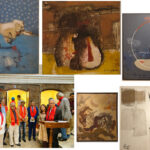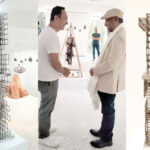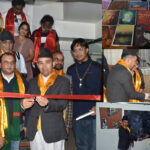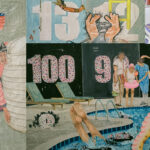Artists often inhabit their own unique realms. Sometimes, the imaginings and visions they experience may elude those engrossed in the everyday pursuit of livelihood. Thus, the world of an artist can feel like a rollercoaster ride, marked by its own highs and lows, a realm unfamiliar to many. Within this community of artists, the name Bijaya Maharjan stands out. From his early years, he carried within him a wealth of stories waiting to be told. He cherishes vivid memories of his school days when his artistic creations were met with appreciation. Over time, he established his own studio, dedicating himself tirelessly to sculpting forms of various shapes and sizes. Given the aesthetic appeal of his works, many art enthusiasts began commissioning sculptures crafted from fiberglass. Gradually, he found himself transformed into a commercial artist. There were moments when he would contemplate, asking himself, ‘Is this the zenith of my creativity?’ When the answer proved negative, he embarked on a quest to express his creativity in new and diverse styles. After amassing a collection of his imaginative art pieces over an extended period, he envisioned displaying them in a gallery setting. This vision materialized at the Takpa Gallery in his inaugural solo exhibition titled ‘Sculpted Vision’ from 7th of October to 11th of November, 2023.

As you step into the gallery, the first sculpture to captivate your gaze is an 8-foot-tall representation of ‘Jatamukut Lokeshwor’ crafted from fiberglass. It is a breathtaking piece that exudes a profound sense of aestheticism in its design. The creator of this sculpture elaborates, “Growing up in a culture where both Buddha and Shiva are revered, I sought to fuse elements of both deities into this single creation. The image embodies the essence of both deities, seamlessly blending elements of masculinity and femininity.”
The sculptor expounds on his artwork, stating, “To imbue any art piece with life, I often contemplate the ‘tribhanga mudra,’ a technique where a sculpture bends at the knees, hips, and shoulders. This method, with its origins tracing back 2000 years, adds a dynamic dimension to the art form.” This technique is also evident in some of his other sculptures.

In his inaugural solo exhibition, the artist takes a bold step by presenting a self-portrait in painting. He emphasizes the pivotal role of drawing as a precursor to sculpting. Intent on not being pigeonholed solely as a sculptor, he creates two paintings that engage in a visual dialogue with each other. With a gleeful disposition, the artist remarks, “People often venerate deities but overlook the hands that crafted them. So, when an artist portrays oneself, why not in the regalia of a king?” In this portrait, he ingeniously incorporates a display rack bearing images of a philosopher, tigers, skulls, and beautiful women—symbols that perpetually occupy the artist’s thoughts.

The artist shares a profound connection with the captivating elegance of feline creatures, evident in the numerous sculptures he has crafted featuring tigers and lions. He expresses, “To harness energy, an artist must draw from the majestic grandeur of these animals.”

Many years ago, he explored the Ajanta caves, where he witnessed a multitude of images seemingly emerging organically from the very stones. These impressions left an enduring mark on his memory. Consequently, the artist incorporates this motif of objects emerging from stone in his work.
In certain sculptures he has crafted, the central theme revolves around a sense of confinement. The act of creating each artwork, for an artist, embodies a form of suffocation. It’s as if the unknown images taking shape emanate from the very walls. When presented in a more imaginative manner, these images can evoke an eerie sensation in the audience. The artist humorously remarks about these pieces, “Even the walls have ears and a breath of their own.”
The displayed images encompass a diverse array of styles and subjects. They span from intricate metalwork, depicting an angel in pursuit of a feathered tiger. The artist chuckles as he shares, “Every human carries a bit of angelic essence within, chasing after countless dreams. The image of the tiger recurs frequently in my sculptures.”

As a sculptor, the artist draws inspiration not only from local sources but also from international artists. A recurring motif in many of his works is the concept of clouds. He associates dreams with these ethereal formations, remarking, “Dreams, much like clouds, can be sensed, yet they elude touch.”
In another series of his work, the artist employs china clay to craft images depicting inseparable spirits, creating the illusion of one image emerging from within another.

Ultimately, an art piece gains its potency through the infusion of artistic energy. The artist’s fervor permeates his creative endeavors, elevating the art to new heights. Many art enthusiasts seize the chance to engage in personal conversations with the artist. If you find yourself in Lazimpat, the Takpa Gallery is a definite must-visit. It offers a serene setting to converse, capture photographs, and relish the sculptures.









Leave A Comment